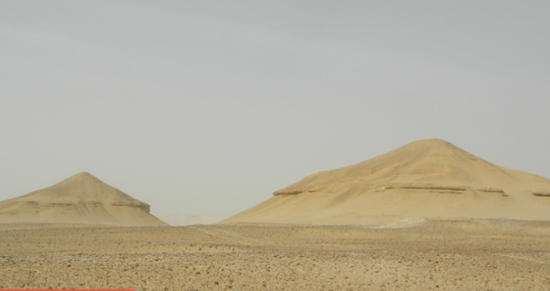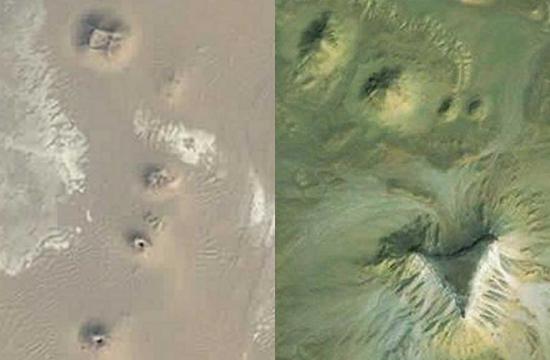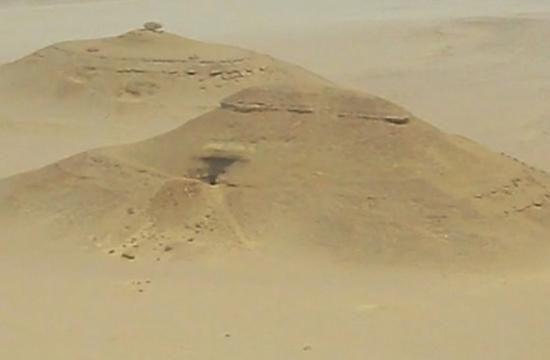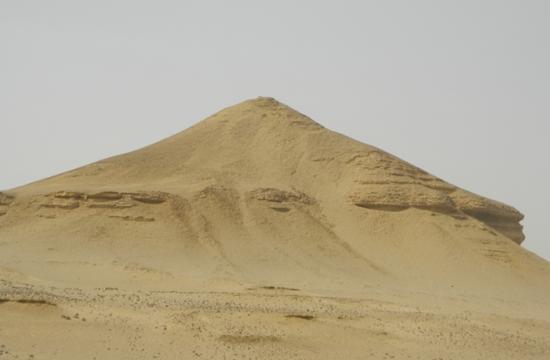Rossella Lorenzi
Source - http://news.discovery.com/history/archaeology/long-lost-pyramids-found-130715.htm

Are these formations in the Egyptian desert long lost pyramids? Or are they just naturally occurring pyramidal rock outcrops? The structures were spotted last year by amateur satellite archaeologist Angela Micol. She used Google Earth 5,000 miles away in North Carolina. MOHAMED ALY SOLIMAN
Mysterious, pyramid-like structures spotted in the Egyptian desert by an amateur satellite archaeologist might be long-lost pyramids after all, according to a new investigation into the enigmatic mounds.
Angela Micol, who last year found the structures using Google Earth 5,000 miles away in North Carolina, says puzzling features have been uncovered during a preliminary ground proofing expedition, revealing cavities and shafts.

Located about 90 miles apart, the two possible pyramid complexes appeared on aerial imagery as an unusual groupings of mounds with intriguing orientations. One site near the Fayum oasis revealed a four-sided, truncated mound approximately 150 feet wide and three smaller mounds in a diagonal alignment (left).The other site, just 12 miles from the city of Abu Sidhum along the Nile, featured two large and two small mounds (right). ANGELA MICOL
"Moreover, it has emerged these formations are labeled as pyramids on several old and rare maps," Micol told Discovery News.
Located about 90 miles apart, the two possible pyramid complexes appeared as groupings of mounds in curious positions.
One site in Upper Egypt, just 12 miles from the city of Abu Sidhum along the Nile, featured four mounds with an unusual footprint.
Some 90 miles north near the Fayum oasis, the second possible pyramid complex revealed a four-sided, truncated mound approximately 150 feet wide and three smaller mounds in a diagonal alignment.
"The images speak for themselves," Micol said when she first announced her findings. "It's very obvious what the sites may contain, but field research is needed to verify they are, in fact, pyramids,"
First reported by Discovery News, her claim gained widespread media attention and much criticism.
Authoritative geologists and geo-archaeologists were largely skeptical and dismissed what Micol called "Google Earth anomalies" as windswept natural rock formations -- buttes quite common in the Egyptian desert.

First reported by Discovery News, Micol’s claim gained widespread media attention and much criticism. Authoritative geologists and geo-archaeologists dismissed what Micol called “Google Earth anomalies” as windswept natural rock formations -- buttes quite common in the Egyptian desert.MOHAMED ALY SOLIMAN
"After the buzz simmered down, I was contacted by an Egyptian couple who claimed to have important historical references for both sites," Micol said.
The couple, Medhat Kamal El-Kady, former ambassador to the Sultanate of Oman, and his wife Haidy Farouk Abdel-Hamid, a lawyer, former counselor at the Egyptian presidency and adviser of border issues and international issues of sovereignty, are top collectors of maps, old documents, books and rare political and historical manuscripts.
El-Kady and Farouk have made important donations to the Egyptian state and the U.S. Library of Congress. Their various gifts to the Library of Alexandria include Al-Sharif Al-Idrissi's map of the Earth drawn for King Roger II of Sicily in 1154.
According to the couple, the formations spotted by Micol in the Fayum and near Abu Sidhum were both labeled as pyramid complex sites in several old maps and documents.
"For this case only, we have more than 34 maps and 12 old documents, mostly by scientists and senior officials of irrigation," El-Kady and Farouk told Discovery News.
For the site near the Fayum, they cited three maps in particular -- a map by Robert de Vaugoudy, dating from 1753, a rare map by the engineers of Napoleon Bonaparte, and a map and documents by Major Brown, general of irrigation for Lower Egypt in the late 1880s.

Suspecting the mounds were ancient in origin, locals tried to dig into one of the two smaller mounds.MOHAMED ALY SOLIMAN

The excavation failed due to striking very hard stone that Aly and Micol believe may be granite.MOHAMED ALY SOLIMAN

Aly Soliman believes the big mounds are hiding pyramids as the metal detector used over them signaled metal and showed an underground tunnel heading north. MOHAMED ALY SOLIMAN

Apart from the two larger and smaller mounds, the expedition team believes the site features a temple or habitation and a row of what may be mastaba tombs adjacent to the mounds. They are shown in the red rectangle thanks to a false color imaging technique developed by Micol. ANGELA MICOL